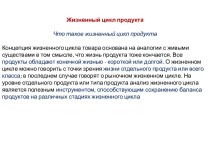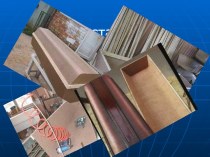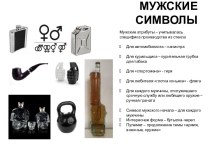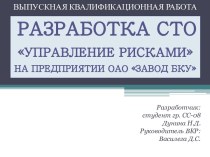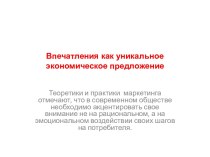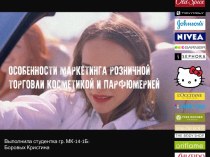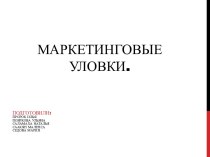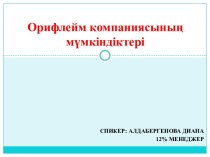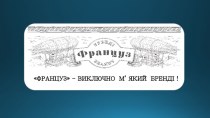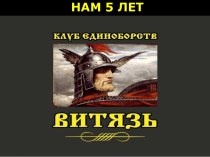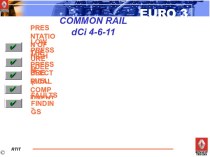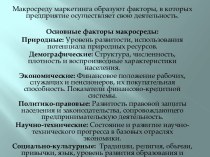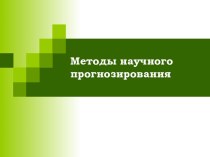- Главная
- Разное
- Бизнес и предпринимательство
- Образование
- Развлечения
- Государство
- Спорт
- Графика
- Культурология
- Еда и кулинария
- Лингвистика
- Религиоведение
- Черчение
- Физкультура
- ИЗО
- Психология
- Социология
- Английский язык
- Астрономия
- Алгебра
- Биология
- География
- Геометрия
- Детские презентации
- Информатика
- История
- Литература
- Маркетинг
- Математика
- Медицина
- Менеджмент
- Музыка
- МХК
- Немецкий язык
- ОБЖ
- Обществознание
- Окружающий мир
- Педагогика
- Русский язык
- Технология
- Физика
- Философия
- Химия
- Шаблоны, картинки для презентаций
- Экология
- Экономика
- Юриспруденция
Что такое findslide.org?
FindSlide.org - это сайт презентаций, докладов, шаблонов в формате PowerPoint.
Обратная связь
Email: Нажмите что бы посмотреть
Презентация на тему How does ZARA operate in the international market
Содержание
- 2. Question 1: Which are the main criteria
- 3. Main criteria that ZARA applies to open
- 4. Main criteria that ZARA applies to open
- 5. Question 2: How would you characterize the lightening- speed production and distribution process of Zara?
- 6. Lightening- speed production and distribution process of
- 7. Lightening- speed production and distribution process of
- 8. Lightening- speed production and distribution process of
- 9. Lightening- speed production and distribution process of
- 10. Lightening- speed production and distribution process of
- 11. Question 3: Why doesn’t ZARA believe in advertising?
- 12. Why doesn’t ZARA believe in advertisingZara spends
- 13. Why doesn’t ZARA believe in advertisingZara justifies
- 14. Question 4: How would you relate the
- 15. Model proposed by Johanson e Vahlne, 1977The
- 16. Model proposed by Johanson e Vahlne, 1977The
- 17. ZARA- Model proposed by Johanson e Vahlne,
- 18. ZARA- Model proposed by Johanson e Vahlne,
- 19. ZARA- Model proposed by Johanson e Vahlne,
- 20. Question 5: “ May no one try
- 21. Is this competitive advantage truly inimitable?
- 22. Major consequences of loosing this advantage Since
- 23. References Johanson J. & Vahlne J-E. (1977),
- 24. Скачать презентацию
- 25. Похожие презентации
























Слайд 3 Main criteria that ZARA applies to open a
new outlet in an international market
Zara has a department,
which exclusively works in acquiring global prime real estate locations.The design department is responsible for the analysis and location of the first store in new markets
Commercial analysis of three months:
analyses the trends and the way the target market dresses
price analysis comparing to the major competitors’ prices to be competitive
The decision for the location of the new stores is based on a provisional results demonstration considering:
price
sales
exploration costs
competition prices, etc.
Слайд 4 Main criteria that ZARA applies to open a
new outlet in an international market
All Zara stores present
a common placing philosophy:To locate near central places or in shopping centres in the major cities
Zara always tries to locate its stores in the most up-market, high traffic, and prestigious locations
With the opening of the first store in a new market starts the “true market analysis”
Слайд 5 Question 2: How would you characterize the lightening- speed
production and distribution process of Zara?
Слайд 6
Lightening- speed production and distribution process of Zara
Zara’s
competitive advantage mainly revolves around the efficient distribution system.
The distribution center is centrally located among fourteen manufacturing plants.About 2.5 million garments could move through the distribution center each week. Zara’s merchandise does not waste time waiting for human sorting. Zara air expresses goods from its single distribution center in Spain, usually in small quantities. In Zara’s strategy, however, the speedy shipments are part of the core strategy.
Слайд 7
Lightening- speed production and distribution process of Zara
Zara’s
high tech distribution system makes sure that no style
sits around for long. The garments are quickly cleared through the distribution center and shipped to stores arriving within 48 hours.
Efficient distribution and inventory systems helps Zara minimize costs and speedy deliveries to the stores across all over the world thus attaining competitive advantage
Finally, Zara's high-tech distribution system ensures that no style sits around very long at head office. The garments are quickly cleared through the distribution centre, and shipped to the stores, arriving within 48 hours. Each store receives deliveries twice a week, so after being produced the merchandise does not spend more than a week at most in transit.
Слайд 8
Lightening- speed production and distribution process of Zara
Half of its production is in owned or closely-controlled
facilities.Zara can move from identifying a trend to having clothes in its stores within 30 days.
This gives Zara a tremendous amount of flexibility and control, it does have to contend with higher people costs.
Catching fashion while it is hot is a clear recipe for better margins with more sales happening at full prices and fewer discounts.
Слайд 9
Lightening- speed production and distribution process of Zara
In comparison, most retailers of comparable size or even
smaller, work on timelines that stretch into 4-12 months(e.g. Zara is twelve times faster than Gap , for H&M it takes three to five months to go from creation to delivery).
Unlike other retailers, Zara's machinery can react to the report immediately and produce a response in terms of a new style or a modification within 2-4 weeks.
The Zara supply chain reacts faster by working with more precise forecasts and more reliable market information.
Rapid movement of new products through the stores, and the knowledge that some of the products may not be replenished, together create an additional incentive for customers to buy on the spot (because if a customer chooses to wait, the item might be sold out and may never be made again)
Слайд 10
Lightening- speed production and distribution process of Zara
Orders are typically ready for shipment 8 hours after
they have been received.Typically, stores in Europe receive their orders in 24 hours, the United States in 48 hours and Japan in 48 to 72 hours.
Speed is clearly an overriding concern; as one of the senior managers put it:
“For us, distance is not measured in kilometers, but in time.”
If a store misses its deadline, it has to wait:
“We are very strict about these deadlines. Orders must be on time”
Miguel Diaz (marketing executive)
Слайд 12
Why doesn’t ZARA believe in advertising
Zara spends around
0.3 % of sales on advertising compared to an
average 3.5% of competitors, choosing highly visible locations for its stores renders advertising unnecessary (and chooses to invest a percentage of revenues in opening new stores instead)Zara has a communication policy for advertising based on WOM communication
The only advertising campaign: biannual one-page publication with sales and ZARA fashion centres
Although the absence of advertising the group has achieved the desired image in terms of positioning, as can be seen by its market share and number of stores
“Our stores and word-of-mouth, do the advertising for us.”
Miguel Diaz (marketing executive)
Слайд 13
Why doesn’t ZARA believe in advertising
Zara justifies the
absence of advertising campaigns by stating that there is
no need for the group to:Arise stores’ sales and visits
Increase the reputation of the chain/ brand Zara
Improve the chain’s image and identity
Zara occupies the second place in Spain in terms of spontaneous notoriety and only in Spain 50million potential customers visit Zara stores annually
Слайд 14 Question 4: How would you relate the internationalization of
ZARA according to the internationalization model proposed by Johanson
e Vahlne, 1977?
Слайд 15
Model proposed by Johanson e Vahlne, 1977
The Internationalization
Process Model (part of the Uppsala Model and developed
by Johanson and Vahlne in 1977) stresses the importance of commitment and knowledge.Explains the internationalization of a firm as a (quite slow) process in which the firm gradually increases its international involvement.
One of the basic assumptions of the model: “the lack of knowledge is an important obstacle to the development of international operations” (Johanson & Vahlne, 1977: 23)
Due to that the internationalization process in their model evolves from interplay between the development of knowledge about the foreign markets and operations, and an increasing commitment of resources to those markets
Слайд 16
Model proposed by Johanson e Vahlne, 1977
The process
is a cycle: knowledge ?commitment decisions? activities ?higher market
commitment ?more knowledge?…..The more experience a firm gains in a market, the bigger the investment and the greater the commitment.
Manufacturing firms develop their international operations in small steps, undertaking incremental commitment decisions and moving at the beginning to psychically close countries in order to reduce the market uncertainty (Johanson & Vahlne, 1977: 24)
Johanson and Vahlne illustrated that the commitment decisions of foreign investments are made due to the market uncertainty, perceived risks and opportunities.
The firm postpones each subsequent step into a certain market until the perceived risk associated with the new investment is lower than the maximum tolerable risk (Johanson & Vahlne, 1977: 34)
Слайд 17
ZARA- Model proposed by Johanson e Vahlne, 1977
The
international strategy of ZARA group consisted in consolidation its
position in the European Union and neighbor countries as well as in North AmericaIn 1989, ZARA started its internationalization process by opening the first stores in Portugal which is a psychically close country to Spain, as Johanson and Vahlne proposed, and gradually until 1994, it also opened stores in France, Belgium, Greece, Mexico and U.S.A.
The growth in Portugal and the experience from this market allowed an important progress on the leading curve for selection, penetration and consolidation of foreign markets.
So, the more the knowledge it gained from a market the more the commitment with the market and the more the experience in order to expand farther.
Слайд 18
ZARA- Model proposed by Johanson e Vahlne, 1977
ZARA
collects market knowledge, not only before it goes abroad
but also while doing business in the host country. This newly gained knowledge is used to e.g. solve problems in the market. To introduce a good daily routine in the new stores provides support and transfers knowledge into the new countriesLike most firms ZARA is constantly learning from its mistakes and newly gained knowledge influences further decisions. In this point the Model corresponds with ZARA’s strategy.
Another accordance between the Internationalization Process Model and ZARA’s reality is the correlation between the increase of knowledge and the increase of commitment. When ZARA enters a country they continue to grow in it. The knowledge ZARA has gathered while being in the new country helps with the other stores to be opened in that host country
Слайд 19
ZARA- Model proposed by Johanson e Vahlne, 1977
Exploring
the case of commitment we see that ZARA is
going in one direction. When it is successful in a new country, it increases its commitment by opening up more new stores. New information and expanding knowledge help to be successful.However, ZARA multitasks globally and its strategy isn’t to enter one country at a time, as the Johanson e Vahlne model which describes the internationalization as a quite slow process.
Слайд 20 Question 5: “ May no one try to do
what ZARA does, because the source of our competitive
advantage is distinctive and inimitable” (Jose Maria Gonzalez). This is a statement referring to the 15th day manufacturing cycle of ZARA as its main factor for competitive advantage. In your opinion is this competitive advantage truly inimitable? What would be the major consequences of loosing this advantage?
Слайд 21
Is this competitive advantage truly inimitable?
Zara’s ability to adapt its products to customer demand
in the shortest time possible, offers a significant advantage over competitors.However,
This 15th day manufacturing cycle of ZARA could be imitable for other competitors , but in practice there are many obstacles , hard to overcome, concerning costs and flexibility.
For ZARA , time is the main factor to be considered, above and beyond production cost. On the contrary, because of the today economy, the intense competitiveness, the lack of coordination, man power and specialization , it’s difficult for other competitors who are not industry leaders(as ZARA) to gain such a competitive advantage .
Слайд 22
Major consequences of loosing this advantage
Since other
competitive companies follow effectively such a strategy, the 15th
day manufacturing cycle will no longer consist a competitive advantage for ZARA.Possible Consequences :
ZARA will have reduction in profits
The competitiveness will be more intense
The company will experience great pressure
Smaller market share
ZARA should strengthen its innovativeness in order to find a new competitive advantage which will be difficult for other competitors to imitate.
Слайд 23
References
Johanson J. & Vahlne J-E. (1977), The
Internationalization process of the firm – a model of
knowledge development and increasing foreign market commitments, Journal of International Business StudiesJose Carlos M.R. Pinho, (2004), International business management.
Website of Wikipedia - http://en.wikipedia.org/wiki/Zara_(clothing)
Website of Zara - www.zara.com/
Ghemawat, Pankaj and Nueno, Jose Luis. “Zara: Fast fashion”, 2003
PDF file - http://www.gallaugher.com/Zara%20Case.pdf
PDF file - http://www.philau.edu/sba/news/zarareport.pdf
http://imtuoradea.ro/auo.fmte/files-2007/MIE_files/Sunhilde_Cuc_2.pdf
http://www.supplychain-forum.com/documents/articles/Case%20Study%20Zara1.pdf
